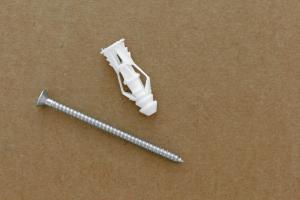Mastering Dry Wall Anchors: A Comprehensive Guide to Installation and Use

-
Quick Links:
- What are Dry Wall Anchors?
- Why Use Dry Wall Anchors?
- Types of Dry Wall Anchors
- Tools and Materials Needed
- Step-by-Step Installation Guide
- Common Mistakes to Avoid
- Real World Case Studies
- Expert Insights
- FAQs
What are Dry Wall Anchors?
Drywall anchors are essential hardware components used to secure objects to drywall. Unlike simple screws, drywall anchors provide additional support, allowing you to hang heavier items without damaging the wall. They come in various types, each designed for specific use cases.
Why Use Dry Wall Anchors?
Using drywall anchors is crucial for several reasons:
- Increased Load-Bearing Capacity: Drywall alone cannot support heavy items. Anchors distribute the weight across a larger area.
- Prevention of Wall Damage: They minimize the risk of crumbling or cracking the drywall.
- Versatility: Suitable for a wide range of applications, from hanging pictures to mounting shelves.
Types of Dry Wall Anchors
There are several types of drywall anchors, each designed for different applications:
- Plastic Expansion Anchors: Ideal for light to medium loads. They expand when a screw is inserted.
- Metal Toggle Bolts: Perfect for heavy items. They use a toggle mechanism to distribute weight across the wall.
- Self-Drilling Anchors: These are easy to install and do not require pre-drilling.
- Masonry Screw Anchors: Designed for use in concrete or masonry walls.
Tools and Materials Needed
Before you start, gather the following tools and materials:
- Drywall anchors (specific type based on your needs)
- Drill and drill bits
- Screwdriver
- Tape measure
- Pencil or marker for marking
- Level (optional, but recommended)
Step-by-Step Installation Guide
Follow these detailed steps to install drywall anchors correctly:
Step 1: Choose the Right Location
Decide where you want to hang your item. Use a level to ensure it’s straight.
Step 2: Mark the Spot
Use a pencil to mark the spot where the anchor will go. Double-check your measurements.
Step 3: Drill a Hole
Using the appropriate drill bit, drill a hole at your marked spot. The size of the hole will depend on the type of anchor you are using.
Step 4: Insert the Anchor
Insert the drywall anchor into the hole. For toggle bolts, you’ll need to fold the toggle before pushing it through the hole.
Step 5: Secure the Screw
Insert the screw through the item you are hanging, then into the anchor. Tighten it until secure, but avoid overtightening as this may damage the drywall.
Step 6: Hang Your Item
Once the screw is secure, hang your item and ensure it is stable.
Common Mistakes to Avoid
- Not choosing the right type of anchor for the weight of the item.
- Over-tightening the screws, which can damage the drywall.
- Failing to check for electrical wires or plumbing behind the wall before drilling.
- Forgetting to use a level, leading to crooked installations.
Real World Case Studies
Case Study 1: Hanging Heavy Shelves
A family wanted to install heavy wooden shelves in their living room. They opted for metal toggle bolts to ensure the shelves could hold books without falling. The installation was successful, and the shelves remain secure years later.
Case Study 2: Mounting a TV
In another scenario, a couple used self-drilling anchors to mount a flat-screen TV. They followed all the steps carefully, resulting in a sturdy installation that supported the TV’s weight perfectly.
Expert Insights
According to home improvement expert Jane Doe, “Choosing the right anchor is critical. Always assess the weight of the item you want to hang and consult with a hardware professional if in doubt.”
FAQs
1. What weight can drywall anchors hold?
The weight capacity of drywall anchors varies by type. Plastic anchors can hold up to 20 lbs, while toggle bolts can support over 100 lbs.
2. Can I use drywall anchors in concrete walls?
No, drywall anchors are specifically designed for drywall. For concrete, use masonry anchors.
3. Do I need to pre-drill for all types of drywall anchors?
Not all anchors require pre-drilling. Self-drilling anchors can be installed without creating a pilot hole.
4. How do I know if my anchor is secure?
Once installed, gently pull on the anchor to check if it feels stable. If it moves, it may not be installed correctly.
5. Can I reuse drywall anchors?
It’s generally not advisable to reuse drywall anchors, as they may not secure properly after removal.
6. What tools do I need for installation?
You will need a drill, drill bits, a screwdriver, a tape measure, and a pencil or marker.
7. How deep should I drill for drywall anchors?
Drill deep enough for the anchor to fit snugly but be cautious not to penetrate too deeply, risking damage to the wall.
8. What happens if I use the wrong anchor?
Using the wrong anchor can lead to failure, resulting in damage to the wall and the item you are trying to hang.
9. Can I use multiple anchors for added support?
Yes, using multiple anchors can provide extra support, especially for heavier items.
10. Are there any safety precautions I should take?
Always check for electrical wires or plumbing lines behind the wall before drilling, and wear safety goggles to protect your eyes.
Random Reads
- Fix leaking refrigerator
- Fix local files not showing in spotify
- Ultimate guide battle frontier emerald
- How to transfer itunes credit to someone else
- How to transfer files linux servers
- How to add mugen characters
- How to add ice to your cell phone
- How to arch a doorway
- How to apply varnish
- Insert symbols in emails